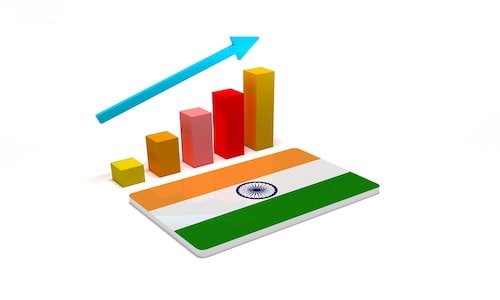According to the latest data released by the Ministry of Statistics on February 28, the growth in India’s gross domestic product (GDP) was higher than the revised 5.6% growth for the July-September 2024 period, but lower than the Reserve Bank of India’s (RBI) estimate of 6.8% for the quarter.
For the full 2024-25 fiscal year (April 2024 to March 2025), the Indian government now forecasts a GDP growth rate of 6.5%, slightly above its initial estimate of 6.4%, but below the revised 9.2% growth for 2023-24. Nevertheless, India remains on track to be the fastest-growing major economy globally, with growth projections for the coming year staying just below 7%.
#GDPData | #GDP growth at 6.2% Vs CNBC-TV18 poll of 6.2%#GDP growth at 6.2% vs 8.6% (YoY) & vs 5.4% (QoQ) pic.twitter.com/CgmRlExSbx
— CNBC-TV18 (@CNBCTV18Live) February 28, 2025
The gross value added (GVA) stood at 6.2%, slightly below the poll estimate of 6.3%. On a yearly basis, GVA growth was lower than 6.8% YoY but higher than 5.6% in Q2FY25. Experts had projected GDP growth to recover to around 6.3% in Q3FY25, driven by increased government spending, up from 5.4% in the previous quarter. Their estimates ranged between 5.8% and 6.5%. In nominal terms, GDP, which accounts for inflation, expanded by 9.9% in Q3 FY25.
According to Chief Economic Adviser V Anantha Nageswaran, India’s economic momentum is expected to persist, supported by a strong rebound in exports and increasing government and private spending and the Mahakumbh effect. These factors are anticipated to keep growth robust in the final quarter of the financial year.
Sector-wise performance in Q3FY25
- Agriculture grew 5.6%, a significant jump from 1.5% YoY and 4.1% QoQ.
- Manufacturing expanded 3.5%, a sharp decline from 14% YoY, but higher than 2.1% QoQ.
- Construction reported 7% growth, lower than 10% YoY but easing slightly from 8.7% QoQ.
- Electricity grew 5.1%, down from 10.1% YoY, but up from 3% QoQ.
- Mining saw a muted growth of 1.4%, compared to 4.7% YoY, but improved from -0.3% QoQ.
- Trade, hotels, transport & communication grew at 6.7%, slower than 8% YoY, but an uptick from 6.1% QoQ.
- Financial services & real estate posted 7.2% growth, down from 8.4% YoY, remaining steady QoQ.
- Public administration, defence & services grew 8.8%, unchanged QoQ, slightly higher than 8.4% YoY.
Industrial and services growth trends
- The industries sector expanded by 4.5%, a steep decline from 11.8% YoY.
- The services sector maintained robust momentum at 7.4%, though lower than 8.3% YoY.
FY25 GDP Growth: Second Advance Estimate
The government’s second advance estimate for FY25 GDP growth stands at 6.5%, slightly ahead of the CNBC-TV18 poll estimate 6.3% but lower than the 9.2% growth in FY24.

The projection is also marginally lower than the Reserve Bank of India’s (RBI) estimate of 6.6%. Nominal GDP growth is expected at 9.9%, lower than the 12% recorded in FY24. Meanwhile, real GVA is seen at 6.4%, compared to 8.6% YoY.

What experts have to say on India’s Q3 GDP growth
Economists React to India’s 6.2% GDP Growth in December Quarter:
Pronab Sen, economist, commented on India’s 6.2% growth in the December quarter, stating, “If past data hadn’t been revised upwards, this 6.2% would have likely been even higher. Given the circumstances, I think we should be optimistic.”
Abhishek Upadhyay, Senior Economist at ICICI Securities, emphasized, “As expected, the acceleration in the third quarter—compared to the 5.6% growth in the second quarter—was largely driven by agriculture and government spending. Government expenditure has surged by nearly 8%. What stands out is the substantial upward revisions to earlier numbers, which could lead to upward adjustments in this year’s growth forecast, suggesting that growth momentum has been stronger as we entered this fiscal year.”
Kaushik Das, Chief Economist at Deutsche Bank, offered a more cautious perspective: “There are multiple ways to interpret the 6.2% growth. If the initial 8.6% growth for October-December 2023 had remained intact, this number should have been above 7.5%. But as we know, GDP data is subject to discrepancies and revisions, and it’s important to scrutinise how these figures have been calculated. Regardless, even if the July-September number is revised up to 6%, it still falls short of the potential growth rate of 7% and indicates a slowdown throughout FY25. While the 6.2% figure for October-December may or may not be higher, it’s the number we have now.
Policymakers will base their decisions on this. Looking ahead, we could see growth in the range of 6.5%-6.7% for January-March, possibly boosted by events like the Mahakumbh Mela. However, the bottom line is that India’s growth this year and next will likely remain around 6.5%, well below the potential growth rate of 7%. This calls for continued policy action to support growth. There are also concerns over how India’s GDP deflator is calculated—using the WPI over more accurate measures can sometimes artificially boost real GDP figures. In the broader picture, India is experiencing a cyclical slowdown, but the worst is likely behind us as of the July-September period. While we expect gradual improvement moving forward, growth will remain below potential for some time, requiring sustained policy support, including from the RBI, along with the impact of recent tax cuts. Growth could stabilise at 6.5% in FY26.”
